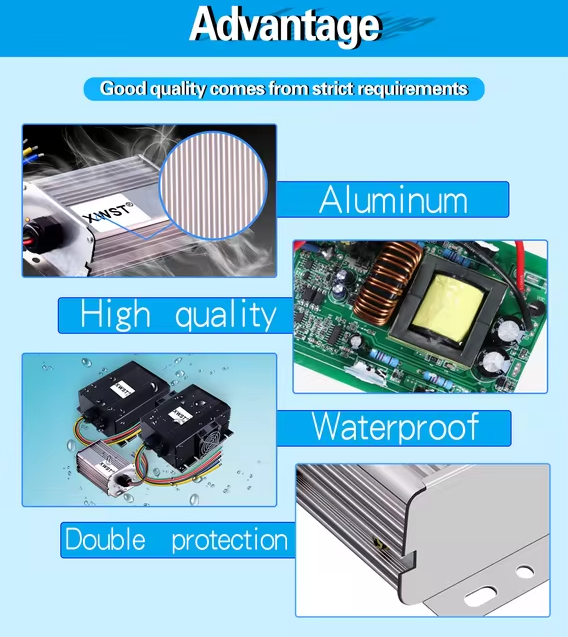As the world continues to evolve towards renewable energy sources and more efficient power storage, the demand for reliable and adaptable battery chargers has surged. Among the most widely used battery types are Lead Acid and Lithium-ion batteries, both of which have specific charging needs. In response to these needs, isolated battery chargers have emerged as a vital technology, offering safety and versatility when charging different battery chemistries. A Lead Acid Lithium Battery Charger Isolated is an essential tool for those who require a charger capable of safely and efficiently charging both lead acid and lithium batteries, while ensuring electrical isolation for safety.
This article provides an in-depth look at the Lead Acid Lithium Battery Charger Isolated, explaining its importance, the technology behind it, its advantages, and how to select the right one for your needs.
What is an Isolated Battery Charger?
An isolated battery charger is designed to keep the charging circuit electrically separated from the power source (usually the mains or external supply). This electrical isolation is achieved using a transformer, which serves to prevent any electrical interference or faults between the charger’s input and output.
The primary purpose of an isolated charger is to provide a safe charging environment by minimizing the risk of short circuits, electrical shocks, and other hazards. The isolation also helps prevent the damage of sensitive components in both the charger and the battery by ensuring stable, clean power delivery. Isolated battery chargers are crucial when working with different types of batteries, as they ensure each battery receives the correct voltage and current without risking overcharging or undercharging.
For applications involving both lead-acid and lithium batteries, an isolated charger is ideal since it can adapt to the distinct charging profiles of both types of batteries, providing a safe and optimized charging process.
Lead Acid vs. Lithium-ion Batteries: Key Differences
Before diving into the specific features of a Lead Acid Lithium Battery Charger Isolated, it’s important to understand the differences between lead-acid and lithium-ion batteries, as this will help in understanding why a specialized charger is necessary for both.
1. Lead Acid Batteries
Lead-acid batteries are among the oldest types of rechargeable batteries and have been in use for over a century. They are commonly used in vehicles, backup power systems, and off-grid applications. Lead-acid batteries are relatively inexpensive and robust, making them a popular choice for many applications. However, they require specific charging protocols to ensure their longevity and performance.
- Charging Characteristics: Lead-acid batteries need to be charged with a constant current and then a constant voltage, with a tapering off phase towards the end of the charging process. Overcharging can lead to gassing and damage the battery, while undercharging can reduce its capacity.
- Capacity and Lifespan: Lead-acid batteries typically have a shorter lifespan than lithium-ion batteries and lower energy density, meaning they store less energy per unit of weight.
2. Lithium-ion Batteries
Lithium-ion batteries have become the standard for modern rechargeable battery technology due to their higher energy density, longer lifespan, and faster charging capabilities. They are used in applications such as electric vehicles, smartphones, laptops, and renewable energy storage systems.
- Charging Characteristics: Lithium-ion batteries require a charging profile that includes a constant current phase followed by a constant voltage phase. However, they are more sensitive to overcharging than lead-acid batteries, which can lead to overheating and permanent damage. Modern lithium-ion batteries often come with built-in battery management systems (BMS) to monitor and manage their charging.
- Capacity and Lifespan: Lithium-ion batteries typically have a longer lifespan (about 2,000 to 5,000 charge cycles) and a higher energy density compared to lead-acid batteries. They are lighter and more compact, making them ideal for portable and high-performance applications.
Why Use a Dual-Purpose Charger?
Given the significant differences in charging requirements between lead-acid and lithium-ion batteries, using a dedicated charger for each type of battery is often the best solution. However, many modern devices, especially in the renewable energy and electric vehicle sectors, require both types of batteries to work together. In such cases, a Lead Acid Lithium Battery Charger Isolated becomes an invaluable tool, as it can intelligently and safely handle both battery chemistries.
Features of a Lead Acid Lithium Battery Charger Isolated
A Lead Acid Lithium Battery Charger Isolated combines the benefits of isolation with the versatility needed to charge both lead-acid and lithium-ion batteries. Here are the essential features to look for in such a charger:
1. Dual Charging Profiles
A Lead Acid Lithium Battery Charger Isolated is designed with dual charging profiles that are tailored to the specific requirements of both battery types. This means the charger will automatically adjust its voltage and current output to match the needs of the connected battery.
- For Lead Acid Batteries: The charger will provide the correct charging cycle that includes a bulk charging phase, an absorption phase, and a float phase to ensure the battery is fully charged without overcharging.
- For Lithium-ion Batteries: The charger will provide a charging profile that matches the battery’s requirements, including a constant current phase and constant voltage phase with precise voltage regulation to protect the battery from overcharging.
2. Electrical Isolation for Safety
The electrical isolation feature is one of the most important aspects of an isolated charger. By separating the input and output circuits, the charger minimizes the risk of electric shocks, short circuits, and damage to sensitive components. The transformer in an isolated charger ensures that the high voltage from the power source does not directly affect the low-voltage battery circuits.
This feature is particularly important when charging lithium-ion batteries, as they are more sensitive to electrical surges or spikes. Additionally, isolation ensures that the charger is more resistant to electrical noise or interference that could compromise its performance.
3. Advanced Protection Mechanisms
Good quality Lead Acid Lithium Battery Chargers Isolated come with built-in protection mechanisms to ensure safe operation. These features typically include:
- Overcharge Protection: To prevent the battery from being overcharged, which can lead to damage, heating, or reduced battery life.
- Short Circuit Protection: To protect both the charger and the battery from damage in the event of a short circuit.
- Overcurrent Protection: To prevent excessive current that could damage the battery or charger.
- Temperature Monitoring: Some advanced chargers feature temperature sensors to prevent overheating, ensuring that the battery is charged within safe thermal limits.
4. Efficiency and Fast Charging
High-efficiency isolated chargers can charge batteries faster without generating excessive heat. This is especially important in applications where rapid charging is necessary, such as in electric vehicles or renewable energy systems. A high-quality charger can offer fast charging times without compromising safety or battery longevity.
5. LED or LCD Display
Many Lead Acid Lithium Battery Chargers Isolated come equipped with an LED or LCD display that provides real-time information about the charging process. This display can show important information such as the charging status, battery voltage, current, and any active protection mechanisms in place.
6. Versatility and Multiple Outputs
Some isolated chargers come with multiple outputs, allowing you to charge more than one battery at a time. Additionally, these chargers are often designed to be compatible with a variety of battery types, including gel, AGM, flooded lead-acid, and lithium-ion batteries.
Benefits of Using a Lead Acid Lithium Battery Charger Isolated
1. Versatility
A charger capable of handling both lead-acid and lithium-ion batteries is highly versatile, especially for systems that use both battery types. Whether you are managing an off-grid power system, an electric vehicle, or a backup power system, such a charger ensures you can maintain all your battery types with a single device.
2. Enhanced Safety
The isolation feature is key to ensuring safety in various charging environments. It protects both users and devices from electrical hazards, minimizing the risk of electrical shocks, fires, and other potential risks associated with improper charging.
3. Cost-Effectiveness
Instead of purchasing separate chargers for each type of battery, a Lead Acid Lithium Battery Charger Isolated allows users to consolidate their charging needs into a single device, making it a more cost-effective solution in the long run.
4. Improved Battery Longevity
With the correct charging profile and protection mechanisms, an isolated charger helps maintain battery health, leading to longer battery life and better performance. Overcharging and undercharging are prevented, ensuring that batteries operate optimally.
Conclusion
A Lead Acid Lithium Battery Charger Isolated is a crucial tool for anyone who uses both lead-acid and lithium-ion batteries, providing a safe, efficient, and versatile solution for charging. By ensuring proper charging profiles, electrical isolation, and safety protections, these chargers help extend the life of batteries and ensure reliable performance. Whether for electric vehicles, off-grid power systems, or renewable energy applications, investing in the right isolated charger can make all the difference in maintaining the health of your batteries and ensuring safe operation.



